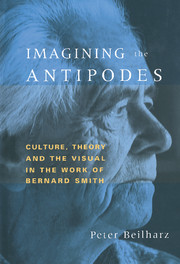Book contents
- Frontmatter
- Contents
- Preface
- Introduction
- Chapter 1 Beginnings
- Chapter 2 Encountering Australian Painting
- Chapter 3 Imaging the Pacific
- Chapter 4 The Antipodean Manifesto
- Chapter 5 Death of the Hero as Artist
- Chapter 6 Modernity, History and Postmodernity
- Chapter 7 Conclusions – Imagining the Antipodes
- Notes
- Index
Chapter 5 - Death of the Hero as Artist
Published online by Cambridge University Press: 22 September 2009
- Frontmatter
- Contents
- Preface
- Introduction
- Chapter 1 Beginnings
- Chapter 2 Encountering Australian Painting
- Chapter 3 Imaging the Pacific
- Chapter 4 The Antipodean Manifesto
- Chapter 5 Death of the Hero as Artist
- Chapter 6 Modernity, History and Postmodernity
- Chapter 7 Conclusions – Imagining the Antipodes
- Notes
- Index
Summary
ARTISTS AS HEROES
We live today in a world after heroes, inasmuch as that is possible. Our lives are prosaic, consistent with the patterns of centuries and civilisations; we seek to make a living, to put food on the table, to keep relationships intact, to care for others. There may, on these levels of everyday life, be ordinary heroes, or ordinary acts of heroism; heroes in the romantic sense are less evident, though our culture still seeks them out and beats them up, in sport or film. As moderns, as Smith claims, we are also ever romantics at the same time; we long for the past, or at least for our roseate images of it, of ways of life suggestive of innocence, simplicity, or the exotic. ‘Hero’: the word, like the image of the antipodes itself, is Greek; and we still live, as westerners, in the shadow of the Greeks, even though the lives of our cities differ so radically from theirs that it is hard to enclose both types of experiences under one word. Yet we still generate myths, and our local white myths still resound back through the western foundational myths of the Greeks and the Bible. All these themes resonate through the work of Bernard Smith. In one essay, he chose explicitly to address some of them. He called it ‘The Death of the Artist as Hero’; it was published in 1976.
- Type
- Chapter
- Information
- Imagining the AntipodesCulture, Theory and the Visual in the Work of Bernard Smith, pp. 127 - 154Publisher: Cambridge University PressPrint publication year: 1997



